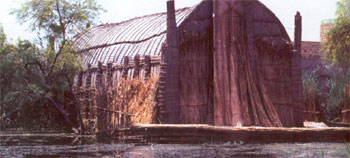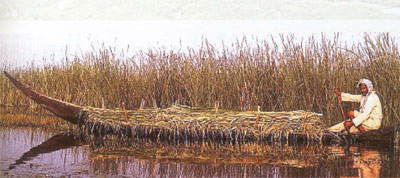|
This is the sad story of
the demise of the Marshes of Iraq, known also by the
name Ahwar or Ahwaz, which is described by the United
Nations as one of the worst environmental disasters in
history.
Iraq is traversed by two
great rivers, the Tigris and the Euphrates, both of
which rise in the eastern mountains of Turkey and enter
Iraq along its northwestern borders. After flowing for
some 1,200 km through Iraq, these two rivers converge
just north of Basrah, to form the tidal Shatt Al Arab
waterway, which flows some 110 km to enter the Gulf. The
Euphrates does not receive any tributaries within Iraq,
while the Tigris receives four main tributaries, the
Khabour, Great Zab, Little Zab and Diyala, which rise in
the mountains of eastern Turkey and northwestern Iran
and flow in a southwesterly direction until they meet
the Tigris River. A seasonal river, Al Authaim, rising
in the highlands of northern Iraq also flows into the
Tigris, and is the only significant tributary arising
entirely within Iraq.

The wetlands in the middle
and lower basin of the Tigris and Euphrates Rivers in
Iraq were, until recently at least, form the most
extensive wetland ecosystems in the Middle East. In
their lower courses, these two great rivers have created
a vast network of wetlands, the Mesopotamian Marshes,
covering about 15,000 sq km. These wetlands comprise a
complex of inter-connected shallow freshwater lakes,
marshes and seasonally inundated floodplains extending
from the region of Basrah in the east to within 150 km
of Baghdad in the west. Winter rains in the headwaters
of the Tigris and Euphrates in southern Turkey, Syria
and northern Iraq cause extensive flooding throughout
Mesopotamia and fill up the lake systems in the south.
Water levels reach their maximum in early spring and
then fall by as much as two metres during the hot dry
summer. Much the largest wetlands within this complex
are: (a) the Hawr Al Hammar and its associated marshes
south of the Euphrates; (b) the Central Marshes, a vast
complex of permanent lakes and marshes north of the
Euphrates and west of the Tigris; and (c) Haur Al
Hawizeh and its associated marshes extending east from
the Tigris into neighbouring Iran. These wetlands
eventually drain southeastwards into the Gulf via the
Shatt Al Arab waterway.
The Mesopotamian
Marshlands are an integral part of the Tigris-Euphrates
river basin shared by Iran, Iraq, Syria, and Turkey.
Some Biblical scholars believe the region to be the site
on which ancient stories of the Garden of Eden and the
Great Flood are based. Up until a dozen years ago, the
Ma'adan, or the Arab Marsh dwellers, led a life
characterized by fishing, farming, weaving, hunting, and
grazing water buffalo, a life not entirely
unrecognizable to their Babylonian and Sumerian
ancestors 5,000 years ago.

The marshland region is
also the site of some of the richest oil deposits in the
country. Iraq's proven oil reserves, estimated at 112
billion barrels, are second only to those of Saudi
Arabia, and its major reserves are in the southern
region. Of those located in the marshlands, the largest
are the Majnun fields with reserves of 10-30 billion
barrels, and West Qurna with reserves of 15 billion
barrels.
Prior to their
destruction, the marshlands (al-Ahwar) had covered an
area of up to 20,000 square kilometers (during the flood
seasons) around the confluence of the Tigris and
Euphrates rivers in southern Iraq. Administratively, the
marshlands cut across three of Iraq's eighteen
provinces: Misan (originally al-`Amara), Dhi Qar
(originally al-Nasiriyya), and Basra. Together, these
wetlands formed a series of interconnected permanent
marshes and lakes covering in the summer an area of some
8,800 square kilometers, but would extend to some 20,000
kilometers when large tracts of dry or desert land were
seasonally inundated.
Throughout Iraq, the level
of exploitation of wetlands is high. The economy of many
of the peoples living in the region has been closely
involved with wetlands for at least 6,000 years.
Civilization was well established in Mesopotamia by the
4th millennium BC, and a sophisticated irrigation system
developed at that time. Floodplain wetlands, river banks
and lake shores are utilized for the cultivation of
cereals, rice or vegetables, while the rivers and lakes
themselves support intensive freshwater fisheries. In
the vast reed-lands of Mesopotamia, marsh-dwelling
communities are almost totally dependent on reeds for
their construction needs. Large numbers of domestic
livestock, particularly water buffalo, are allowed to
graze on wetland vegetation, and aquatic plants are
harvested to provide fodder during the winter months.
Until the 1950s, the
traditional subsistence lifestyle of the people had
hardly been disturbed. Their largely self-sufficient
economy, structured around the aquatic environment, was
based on the traditional occupations of fishing,
cultivation, buffalo breeding, and reed gathering (from
which a cane handicrafts industry evolved). Migration to
urban centers, whether for permanent or seasonal work,
accounted for much of the reduction in the size of the
indigenous population up to the late 1980s, when the
government policies targeting the Marsh Arabs described
in this briefing dramatically increased the pace of
depopulation.
Life in the marshes was
extremely hard, and as Iraq became increasingly
prosperous during the 1960s and 1970s and even into the
1980s, the lack of amenities and the harsh environment
would have encouraged many marsh dwellers, particularly
educated young people, to leave for the cities. Urban
economic activity became the main source of income for
many families even though, geographically and
administratively, the marshlands themselves remained
relatively isolated. Even by the early 1970s, the
encroachment of the Iraqi state-in the form of
educational and health services as well as the permanent
presence of law enforcement and administrative
personnel-had only reached the outer and more accessible
fringes of the marshlands. It was only during and in the
aftermath of the Iran-Iraq war that the Iraqi government
began to draw up plans for direct military intervention
in the area.
In 1991, shortly after the
first Persian Gulf War ended, the government, angered by
Marsh Arab participation in the southern uprising
against the regime, launched an assault on the southern
wetlands and the inhabitant Marsh Arabs. The assault
included burning villages, summary executions and
"disappearances," and a multi-year, sophisticated
campaign of water diversion and marsh drainage that has
reduced roughly 93 percent of the marshes to dry,
salt-encrusted wasteland.
Extensive damming by
Turkey and Syria in the 1950s in the upper
Tigris-Euphrates river basin also negatively impacted
the marshlands, but the majority of the destruction of
the teeming Iraqi wetlands that are larger than
Florida's Everglades began with Saddam Hussein's
campaign.
A report released by the
United Nations Environment Programme (UNEP) in 2001
alerted the world that only about 7 percent of the
once-extensive marshlands remained. Satellite evidence
showed the wetland complex, which the report called "a
biodiversity center of global importance," had shrunk to
a 386-square-mile (1,000-square-kilometer) marsh
straddling the Iran-Iraq border.
UNEP described it as one
of the worst environmental disasters in history, ranking
it with the desiccation of the Aral Sea and the
deforestation of the Amazon rainforests. The marshlands
are a breeding ground and stop-over point for migratory
birds. The environmental degradation put an estimated 40
species of birds and untold species of fish at risk, and
led to the extinction of at least seven species. Two
other species-the Sacred Ibis and African Darter-are
near extinction. These marshlands now contain a handful
of the species that once made the area home. Several of
these unique species, like the smooth-covered otter and
the bandicoot rat may now be extinct. Fishes from the
coastal fisheries depended on the marshes for spawning.
Migratory birds from Asia, Europe, and South Africa
which used to flock to the marshes, now have no where to
go. The marshes are also home to many endangered
species, which now have an even lesser chance of
survival. It is estimated that over 40 species of
waterfowl and migratory birds are now threatened. This
is directly due to the destruction of the wetlands.
Destruction of the
wetlands was also devastating to agriculture and water
quality, and many of the Marsh Arabs were forced to move
to Iran or became internally displaced in Iraq. In the
long term, the drying of the marshes could contribute to
climate change in the region.
The marshlands Arabs whose
unique way of life had been preserved for over 5,000
years, consist of a number of different Shi'a tribes.
Estimates of population size have varied largely. One
anthropological study put their number at 400,000 in the
1950s. Economic migration between the 1960s and the
1980s had reduced the population to an estimated 250,000
by 1991. In 1993, Human Rights Watch estimated the rural
population of the marshlands to be around 200,000, which
took into account the huge numbers of army deserters and
political opponents seeking shelter in the region after
1991. Today, there may be as few as 20,000 of the
original inhabitants remaining, the rest having fled or
migrated to Iran and elsewhere, while an estimated
minimum of 100,000 have become internally displaced in
Iraq.
In recent times, there had
been several plans to restore some of the marshes. But
in several instances, the motives behind those plans had
been quite suspicious. Even when Western parties laid
down such plans, it was clear that they had their eyes
on the vast oil reserves of the area. However, with the
occupation of Iraq, and the ensuing resistance, it is
feared that even such plans are being shelved for the
time being till full security is maintained. This looks
quite far at present.
|
